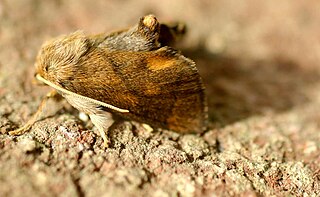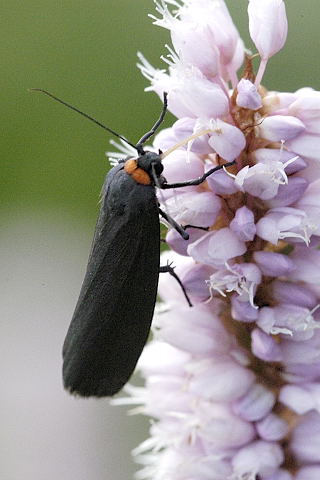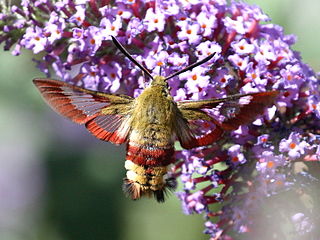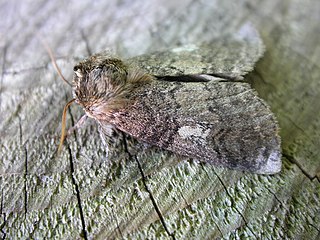
The bordered white or pine looper, is a moth of the family Geometridae. Among these, it belongs to tribe Bupalini of the subfamily Ennominae. B. piniaria is a common species throughout the western Palearctic region, the Near East and North Africa. However, its presence in certain regions – e.g. the northern Balkans – is doubtful.

Abraxas sylvata, the clouded magpie, is a Palearctic moth of the family Geometridae that was named by Giovanni Antonio Scopoli in 1763.

Oncocera semirubella, the rosy-striped knot-horn, is a small moth of the family Pyralidae.

Apoda limacodes, also known as the festoon, is a species of moth of the family Limacodidae.

Atolmis rubricollis, the red-necked footman, is a small moth of the family Erebidae. It is found in the summer in forested regions of Europe and Northern Asia. This moth was first described by Carl Linnaeus in his 1758 10th edition of Systema Naturae.

Falcaria lacertinaria, the scalloped hook-tip, is a moth of the family Drepanidae. The species was first described by Carl Linnaeus in his 1758 10th edition of Systema Naturae It is found in Europe and Anatolia then east to Eastern Siberia.

Hemaris fuciformis, known as the broad-bordered bee hawk-moth, is a moth of the family Sphingidae.

Chamaesphecia empiformis is a moth of the family Sesiidae.

Pennisetia hylaeiformis, the raspberry clearwing, is a moth of the family Sesiidae.

Poecilocampa populi, the December moth, is a moth of the family Lasiocampidae.

Tethea or, the poplar lutestring, is a moth of the family Drepanidae. It was first described by Michael Denis and Ignaz Schiffermüller in 1775. The species can be found in Europe, northern and eastern Asia and Japan. The imago resembles Tethea ocularis.
Chamaesphecia mysiniformis is a moth of the family Sesiidae. It is native to the Iberian Peninsula, southern France, and northern Morocco, but has been introduced to Victoria, Australia in 1997.

Chamaesphecia is a genus of moths in the family Sesiidae.

Chamaesphecia hungarica, the Hungarian clearwing moth, is a moth of the family Sesiidae. It is native to the south-eastern Czech Republic and Slovakia, Austria, Hungary, Serbia and Croatia. It was originally approved for introduction into the United States in 1993. It has been released at several leafy spurge-infested sites in Montana and North Dakota.
Chamaesphecia aerifrons is a moth of the family Sesiidae. It is found in Morocco, Algeria, Tunisia, Spain, Portugal, France, southern Belgium, south-western Germany, Italy, Sicily, Dalmatia, the Republic of Macedonia, Albania, northern Greece and on Crete, Sardinia and Corsica.

Chamaesphecia chalciformis is a moth of the family Sesiidae. It is found in Italy, Austria, Slovakia, the Balkan Peninsula, Ukraine, Russia, Turkey, the Middle East and northern Iran.
Chamaesphecia doleriformis is a moth of the family Sesiidae. It is found in Italy, Austria, the Czech Republic, Slovakia, the Balkan Peninsula, Ukraine, Russia and Turkey.

Chamaesphecia masariformis is a moth of the family Sesiidae. It is found in south-eastern Europe, Turkey, northern Iran, the Middle East, the Caucasus, southern Russia, Uzbekistan and Tajikistan.
Chamaesphecia schmidtiiformis is a moth of the family Sesiidae. It is found in Italy, the Balkan Peninsula and Ukraine. It is also found from Turkey to the Black Sea coast, the Caucasus, Turkmenistan and Iran.

















